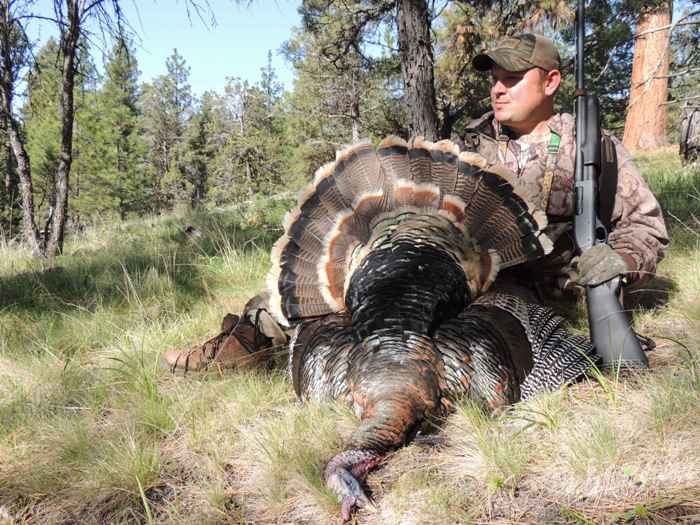Gearing up for Spring Turkey Season
By Gary Lewis

My taste in shotguns runs to wood and blued steel, I like two barrels, one on top of the other or side by side, but last year I won a Weatherby SA-08 semi-automatic with a five-dollar ticket in a raffle.
I didn’t need another shotgun I told myself, but then Ireflected on a day in a turkey blind a few years ago. We had set up in what Iguessed was the birds’ daily travel route. When the first big gobbler strolledinto range, I centered the bead on him and squeezed the trigger.
Now I had patterned the gun the day before with Federal Premium Mag-Shok, but that bird walked right back out of range. Yes, I missed,but there must have been a turkey-head-shaped hole in the pattern at 20-plus yards.
That’s the target - that bobbing, weaving red, white and blue noggin with a beak, snood and wattles.
As I fondled that new matte-finished auto-loader with its synthetic stock, I pictured my perfect, dedicated turkey gun.
Like a compound bow, a turkey gun can be set up as simply or as complex as the hunter’s taste; it becomes a highly personalized tool.
Turkey guns, like turkey hunters, come in all shapes and sizes. For some years, the ultimate turkey guns were long-barreled, with tight chokes, matte finishes,synthetic stocks and fiber optic sights. 12 gauge is the standard, but some hunters opt for 10 gauge to get a few more feet of effective range. There is no one-size-fits-all approach.
A few years ago, I interviewed outdoor writer M.D. Johnson about his turkey gun. M.D. is taller than most, but he carries a youth model Remington 870 20-gauge pump that he has modified to fit his frame and deliver aload out to 40 yards and beyond.
TV host and outdoor writer Scott Haugen, who makes his home east of Eugene,prefers a pistol-gripped, camouflaged Mossberg Turkey Thug pump-action 12-gauge. In his new book, Western Turkey Hunting (2013, Haugen Enterprises),Haugen recommends a barrel length of 20 to 24 inches and an overall weight of 6.5 to 8 pounds. He suggests an aftermarket turkey choke and either a fiber-optic sight or a red dot reflex like the Trijicon RMR.
As important as the sight and the choke, the choice of ammunition is critical. Most turkey hunters opt for No. 4 to No. 6 shot.Pattern it before the hunt. A two-ounce load of No. 6 lead carries about 450 pellets, but at 30 or 40 yards, the pattern might be so dispersed that it might completely miss a turkey’s head. When sighting-in, look for the load that puts at least 10 pellets in a turkey head-sized target at 35, 40 or 45 yards.
Last year, I hunted with Troy Rodakowski, a writer from Junction City. He carried a 12-gauge Remington 870 SPS topped with a TruGlo sight and a specialized turkey choke, stoked with 3-1/2-inch loads of No. 4 shot.
When we heard the first gobbles of the morning, we located three different toms, all on the move, headed down a series of ridges toward the creek bottom. After an hour of cat-and-mouse, Troy dropped down behind a log and I tucked in against a tree and pulled up my face mask.
In my hand was the Weatherby, modified with a TruGlo Bone Collector choke tube and fiber-optic front and rear sights. The front sight found the bird at 23 yards and he went down hard. The Central Oregon gobbler sported a broomed-off 7-1/2-inch beard and one-inch worn-down spurs.
Today, I replaced the magazine plug, installed a Quake sling, screwed the choke back in and wrapped the fore-end and the stock with Camo Form fabric to break up the shape of the gun. Next time I go to the range,I’m going to try out some new turkey loads.
With a mild winter all but behind us, I am looking forward to a great spring turkey season.
Oregon’s turkey season runs April 15 through May 31. The daily bag limit is one male or one turkey with a beard. Hunters are allowed two turkeys for the season, except that a third may be taken in some counties. A separate tag is required for each turkey. For a look at the 2012 spring wild turkey harvest by management unit, visit www.dfw.state.or.us then click on upland bird harvest and statistics.



